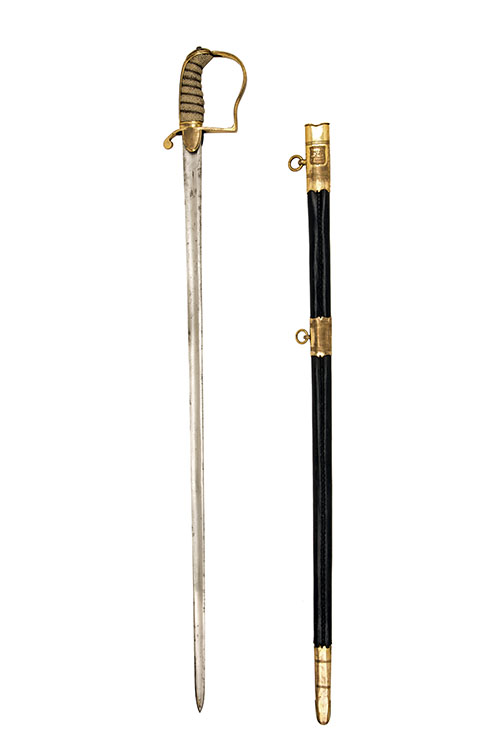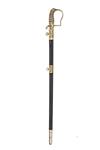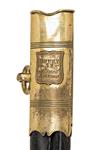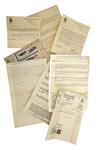Product Details
DRURY, LONDON
AN HISTORICALLY IMPORTANT NAVAL 1805 REGULATION TYPE MIDSHIPMAN'S SWORD,
the blade circa 1806, 32in. in length with broad fuller (traces of Georgian style engraving), the back edge of blade marked 'JOSEPH WILLIAM CRABBE (sic) HMS UNITE' spear point, the 'P' shaped gilded brass hilt with turned down quillion and broad langets, replacement white sharkskin grip, gilded brass doveshead backstrap and pommel, complete with its gilded brass mounted black leather scabbard (leather renewed), the locket with raised shied escutcheon signed 'DRURY, 52 STRAND LONDON', together with paperwork and research on Crabb and the sword.
Provenance: Joseph William Crabb (the additional 'e' at the end of his name is attributed to an over zealous engraver) entered the Navy on September 4th 1801 as a Midshipman, serving on board the Royal Sovereign, the 100 gun flagship of the channel fleet of Sir Henry Harvey, under Captain Baggett. He then served under various captains, mainly in the Mediterranean. Around 1807 he found himself serving on a frigate 'The Chiffonne' under a Captain P. Campbell. The pair transferred to another frigate, The Unite, upon which Crabb served until October 1815. In 1809 he was promoted to Lieutenant, and in 1810, whilst in pursuit of an enemy vessel, he received a serious wound to the groin caused by a Langridge shot, an early type of canister shot firing approximately 1in. diameter iron balls, one of which remained lodged inside him for the rest of his life. Involved in the capture of numerous French vessels whilst commanding the Unites own boats, he served on board as the senior Lieutenant until 1815, finishing his career on the Orontes under Captain Cochrane in 1816.
Because of Crabb's distinguished service he was placed on Reserve half pay, and in 1848 was awarded the Naval General Service Medal for actions carried out in 1811. Promoted to Commander in 1851 under the order of the Council, one of only 50 lieutenants to be so treated, he remained on the Reserve list until his death in mid 1877.
History of the Unite
In 1788, the French ship Imperieuse cruised in the Middle East, followed by the Aegean Sea for the two following years. She performed another cruise off the Middle East before returning to Toulon. On 11 October 1793, Imperieuse was captured off La Spezia by HMS Captain and the Spanish ship of the line Bahama following the Raid on Genoa.
The Royal Navy subsequently commissioned Imperieuse as the fifth rate frigate 'HMS Imperieuse', entering service in 1795 and operating in the West Indies off Martinique and Surinam for most of the French Revolutionary Wars under the command of Captain John P. Beresford. Imperieuse returned to Britain at the Peace of Amiens.
When the Napoleonic Wars started, Imperieuse was renamed Unite and returned to service in the Mediterranean. The frigate was under the command of Captain Chaloner Ogle as one of Nelson scouts, but not present at Trafalgar; instead, she lay unmasted in Lisbon harbour. Unite, Melpomene and Weazel shared in the capture of the Buona Esperanza on 19 July 1807 and then the Bizarro on 21 August. The bankruptcy of the prize agents meant that some prize money was not distributed until 21 years later, in 1828. The fourth and final payment for Bizarro did not occur until July 1850.
Under Captain Patrick Campbell, Unite was the first frigate to enter the Adriatic Sea and during the spring of 1808 captured a string of French and Italian gunboats and coastal merchant vessels, notably the 16-gun sister-brigs Ronco, Teulié and Nettuno, the first on 2 May 1808 off Cape Promontore, Istria, and then the second two on 1 June 1808 off Zara. Campbell reported no casualties in the capture of Ronco. Teulié lost five men killed and 16 wounded before she surrendered; Nettuno lost seven killed, two drowned, and 13 wounded. The Royal Navy took all three into service, Ronco under the name HMS Tuscan, Teulié under the name HMS Roman, and Nettuno under the name HMS Cretan. On 19 May 1810 Unite captured the French privateer Du Guay Trouin of 10 guns and 116 men.
By 1811 Unite was still operating in the Mediterranean, under Captain Chamberlayne. On 31 March 1811, Unite and Ajax encountered a French squadron comprising the frigates Adrienne and Amélie, and the armed transport French corvette Dromadaire. Ajax captured Dromadaire, while the frigates managed to escape to Portoferraio. Captain Otway of Ajax reported that Dromadaire was frigate-built and sailed remarkably well. Her cargo consisted of 15,000 shot and shells of various sizes and 90 tons of gunpowder. Apparently Napoleon Bonaparte intended them as a present for Hammuda ibn Ali, the Bey of Tunis. Admiral Sir Charles Cotton, commander in chief of the British Mediterranean Fleet, decided to buy her and her stores for the Royal Navy.
On 1 May, Unite participated in the destruction of the French vessels Giraffe, Nourrice, and an armed merchant man sheltering near the island at Sagone, with the help of HMS Pomone and HMS Scout. Throughout the summer she continued to operate off the mouth of the Tiber and in the autumn she was once again sent to the Adriatic, participating in the Action of 29 November 1811 at which she captured the armed storeship Persanne. On 16 June 1812 boats from Unite, Orlando and Cerberus captured three vessels all from eighty to one hundred tons in the small port of Badisea, near Otranto. On 9 November 1812 Unite was in sight when Furieuse captured Nebrophonus.
By 1815, Unite was back in Britain in reserve at Deptford and she remained there until converted for harbour service in 1832. Between 1841 and 1858, she was used as a prison hulk. The ship was eventually broken up in January 1858 at Chatham Dockyard.
Other Notes: According to notes from the National Maritime Museum (included), this regulation Midshipmans sword was probably modified on Crabb's request whilst he was on the Reserve list. Rather than purchasing a new sword, this one has been updated with a replacement grip from an1827 pattern version. The scabbard was repaired by Wilkinsons in the 1960's.
Please click HERE to view Terms & Conditions.
Estimate £1,500-2,500







